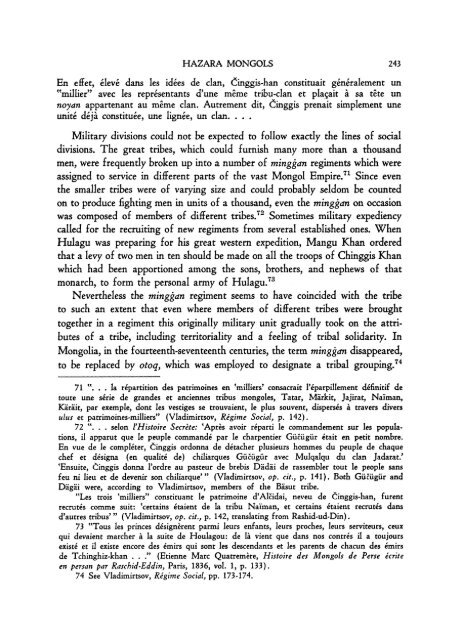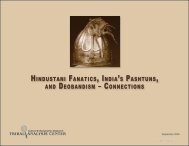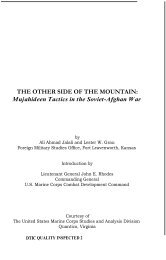the inquiry into the hazara mongols of afghanistan - Tribal Analysis ...
the inquiry into the hazara mongols of afghanistan - Tribal Analysis ...
the inquiry into the hazara mongols of afghanistan - Tribal Analysis ...
You also want an ePaper? Increase the reach of your titles
YUMPU automatically turns print PDFs into web optimized ePapers that Google loves.
HAZARA MONGOLS 243En effet, eleve dans les idees de clan, Cinggis-han constituait generalement un"millier" avec les representants d'une meme tribu-clan et plaSait a sa tete unnoyan appartenant au meme clan. Autrement dit, Cinggis prenait simplement uneunite deja constituee, une lignee, un clan ....Military divisions could not be expected to follow exactly <strong>the</strong> lines <strong>of</strong> socialdivisions. The great tribes, which could furnish many more than a thousandmen, were frequently broken up <strong>into</strong> a number <strong>of</strong> minggan regiments which wereassigned to service in different parts <strong>of</strong> <strong>the</strong> vast Mongol Empire.71 Since even<strong>the</strong> smaller tribes were <strong>of</strong> varying size and could probably seldom be countedon to produce fighting men in units <strong>of</strong> a thousand, even <strong>the</strong> minggan on occasionwas composed <strong>of</strong> members <strong>of</strong> different tribes.72 Sometimes military expediencycalled for <strong>the</strong> recruiting <strong>of</strong> new regiments from several established ones. WhenHulagu was preparing for his great western expedition, Mangu Khan orderedthat a levy <strong>of</strong> two men in ten should be made on all <strong>the</strong> troops <strong>of</strong> Chinggis Khanwhich had been apportioned among <strong>the</strong> sons, bro<strong>the</strong>rs, and nephews <strong>of</strong> thatmonarch, to form <strong>the</strong> personal army <strong>of</strong> Hulagu.73Never<strong>the</strong>less <strong>the</strong> minggan regiment seems to have coincided with <strong>the</strong> tribeto such an extent that even where members <strong>of</strong> different tribes were broughttoge<strong>the</strong>r in a regiment this originally military unit gradually took on <strong>the</strong> attributes<strong>of</strong> a tribe, including territoriality and a feeling <strong>of</strong> tribal solidarity. InMongolia, in <strong>the</strong> fourteenth-seventeenth centuries, <strong>the</strong> term minggan disappeared,to be replaced by otoq, which was employed to designate a tribal grouping.7471 "... la repartition des patrimoines en 'milliers' consacrait l'eparpillement definitif detoute une serie de grandes et anciennes tribus mongoles, Tatar, Markit, Jajirat, Naiman,Karait, par exemple, dont les vestiges se trouvaient, le plus souvent, disperses a travers diversulus et patrimoines-milliers" (Vladimirtsov, Regime Social, p. 142).72 ". . . selon l'Histoire Secrete: 'Apres avoir reparti le commandement sur les populations,il apparut que le peuple commande par le charpentier Giiiigiir etait en petit nombre.En vue de le completer, Cinggis ordonna de detacher plusieurs hommes du peuple de chaquechef et designa (en qualite de) chiliarques Giiciigiir avec Mulqalqu du clan Jadarat.''Ensuite, Cinggis donna l'ordre au pasteur de brebis Dadai de rassembler tout le people sansfeu ni lieu et de devenir son chiliarque'" (Vladimirtsov, op. cit., p. 141). Both Giiiigiir andDagai were, according to Vladimirtsov, members <strong>of</strong> <strong>the</strong> Bisut tribe."Les trois 'milliers" constituant le patrimoine d'Alcidai, neveu de Cinggis-han, furentrecrutes comme suit: 'certains etaient de la tribu Naiman, et certains etaient recrutes dansd'autres tribus'" (Vladimirtsov, op. cit., p. 142, translating from Rashid-ud-Din).73 "Tous les princes designerent parmi leurs enfants, leurs proches, leurs serviteurs, ceuxqui devaient marcher a la suite de Houlagou: de 1a vient que dans nos contres il a toujoursexiste et il existe encore des emirs qui sont les descendants et les parents de chacun des emirsde Tchinghiz-khan. . ." (Etienne Marc Quatremere, Histoire des Mongols de Perse ecriteen persan par Raschid-Eddin, Paris, 1836, vol. 1, p. 133).74 See Vladimirtsov, Regime Social, pp. 173-174.
















